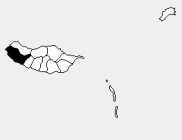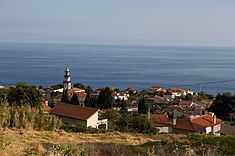Arco da Calheta
| Arco da Calheta | ||
| Civil Parish | ||
 A paraglider over the locality of Achada de Santo Antão, the parish of Arco da Calheta | ||
|
||
| Official name: Freguesia de Arco da Calheta | ||
| Name origin: Portuguese for arch of the small bay | ||
| Country | ||
|---|---|---|
| Region | ||
| Island | Madeira | |
| Municipality | Calheta | |
| Coordinates | 32°44′4″N 17°8′4″W / 32.73444°N 17.13444°WCoordinates: 32°44′4″N 17°8′4″W / 32.73444°N 17.13444°W | |
| Highest point | ||
| - elevation | 1,412 m (4,633 ft) | |
| Lowest point | ||
| - elevation | 0 m (0 ft) | |
| Area | 14.70 km2 (6 sq mi) | |
| Population | 3,168 (2011) | |
| Density | 216 / km2 (559 / sq mi) | |
| Settlement | fl. 1500 | |
| - Parish | c. 1572 | |
| LAU | Junta Freguesia | |
| - location | Sítio da Fonte Bugia | |
| President Junta | José Manuel Rodrigues Paulo (PPD-PSD) | |
| Timezone | WET (UTC0) | |
| - summer (DST) | WEST (UTC+1) | |
| Postal Zone | 9370-024 | |
| Area Code & Prefix | (+351) 291 XXX XXX | |
 Location of the parish seat of Arco da Calheta in the municipality of Calheta, island of Madeira
| ||
| Wikimedia Commons: Arco da Calheta | ||
Arco da Calheta is a civil parish in the municipality of Calheta in the Portuguese island of Madeira. The population in 2011 was 3,168,[1] in an area of 14.70 km².[2] Arco da Calheta is the largest parish in Calheta in population.
Geography

The parish of Arco da Calheta is surrounded to the north and west by the parish of Calheta, and east by the municipality of Ponta do Sol (specifically the parishes of Canhas and Madalena do Mar), fronting the Atlantic Ocean along its southern border. Buildings are found in the amphitheatre-shaped valley, as well as on the escarpments overlooking the community, alongside Calheta (in Calhau Grande) and Madalena do Mar (Achada de Santo Antão). Its landscape within this semi-circular valley was the basis for its name; the early settlers, owing to the band/arch of settlements with the valley, baptized the region the "Arch of Calheta", or Arco da Calheta. A band of laurisilva forests subdivides the parishes built-up area from the barren vegetation of the mountains.
